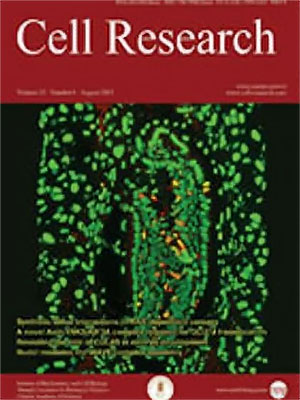
Volume 15, No 8, Aug 2005
ISSN: 1001-0602
EISSN: 1748-7838 2018
impact factor 17.848*
(Clarivate Analytics, 2019)
Volume 15 Issue 8, August 2005: 639-657
ORIGINAL ARTICLES
Transcription analysis of peloric mutants of Phalaenopsis orchids derived from tissue culture
Ya Huei CHEN1, Yi Jung Ya Huei CHEN1, Yi Jung CHEN1,2,3,*
1Institute of Tropical Agriculture & International Cooperation, National Pingtung University of Science & Technology,
Pingtung 91201, Taiwan
2Institute and Department of Plant Industry, National Pingtung University of Science & Technology, Pingtung 91201,
Taiwan
3Institute of Biotechnology, National Pingtung University of Science & Technology, Pingtung 91201, Taiwan
Correspondence: Fure Chyi CHEN(fchen@mail.npust.edu.tw)
Tissue culture has been widely used for mass propagation of Phalaenopsis. However, somaclonal variation occurred during micropropagation process posed a severe problem by affecting product quality. In this study, wild type and peloric flower buds of Phalaenopsis hybrids derived from flower stalk nodal culture were used for cDNA-RAPD and cDNA suppression subtractive hybridization analyses in order to study their genetic difference in terms of expressed sequence tags. A total of 209 ESTs from normal flower buds and 230 from mutants were sequenced. These ESTs sequences can be grouped into several functional categories involved in different cellular processes including metabolism, signal transduction, transcription, cell growth and division, protein synthesis, and protein localization, and into a subcategory of proteins with unknown function. Cymbidium mosaic virus transcript was surprisingly found expressed frequently in the peloric mutant of P. Little Mary. Real-time RT-PCR analysis on selected ESTs showed that in mutant flower buds, a bZIP transcription factor (TGA1a-like protein) was down-regulated, while up-regulated genes include auxin-regulated protein kinase, cyclophilin, and TCP-like genes. A retroelement clone was also preferentially expressed in the peloric mutant flowers. On the other hand, ESTs involved in DNA methylation, chromatin remodeling and post-transcriptional regulation, such as DNA methyltransferase, histone acetyltransferase, ERECTA, and DEAD/DEAH RNA helicase, were enriched in normal flower buds than the mutants. The enriched transcripts in the wild type indicate the down regulation of these transcripts in the mutants, and vice versa. The potential roles of the analyzed transcripts in the development of Phalaenopsis flowers are discussed.
FULL TEXT | PDF
Browse 2017


